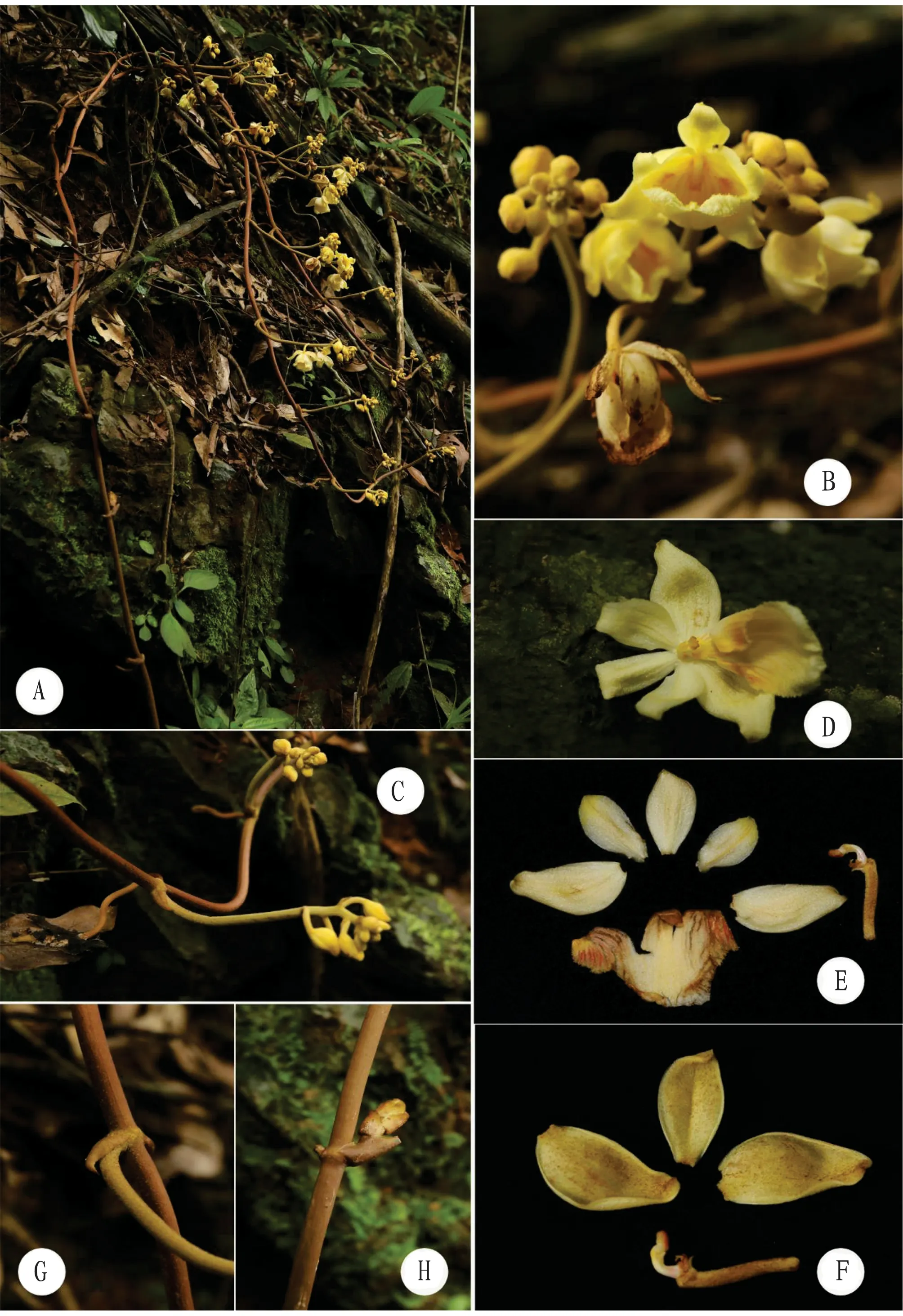A New Record of Orchidaceae from Guangxi: Galeola nudifolia Lour.
2021-01-27XueqiangCUIChangyanHUANGJielingDENGQianSONGHaixiaYANXuanTANGZibinZHANG
Xueqiang CUI, Changyan HUANG, Jieling DENG, Qian SONG, Haixia YAN, Xuan TANG, Zibin ZHANG
Flower Research Institute, Guangxi Academy of Agricultural Sciences, Nanning 530007, China
Abstract This paper reported a new record of Orchidaceae from Guangxi, Galeola nudifolia Lour. This species was previously known from Hainan Province and Yunnan Province of China, India, Myanmar, Vietnam, Thailand, Malaysia, Indonesia and the Philippines. The new Orchidaceae record has broken the record of only one species of the genus Galeola Lour. in Guangxi, and it filled the gap in the northern part of the original distribution area, and proved that the species in general is in a continuous distribution state. The new Orchidaceae record in Guangxi is of great significance to the study of the distribution pattern and geographical origin of the species.
Key words Guangxi Zhuang Autonomous Region, Orchidaceae, New record, Galeola nudifolia Lour.
1 Introduction
Orchid plants, as a major family of angiosperms[1], include 6 subfamilies, about 725 genera, and 25 000-30 000 species in the world[2-3]. Except for areas with extremely harsh habitats, orchid plants are distributed in almost all over the world’s terrestrial ecosystems, they are especially abundant in tropical regions of Asia and America[4]. In angiosperms, orchid plants have the highest degree of evolution, their flower structure is exquisite, and orchid plants have important scientific research value, ornamental value[5]and economic value[6]. Because their growth is highly dependent on the specific habitat environment[7-8], orchid plants have become a key object of biodiversity conservation. Making clear the types and distribution of orchid plants is an important basis for their protection and research.
GaleolaLour. belongs to Subtrib. Vanillinae of Subfam. Orchidoideae in Trib. Epidendreae and is a transitional group of saprophytic herbs to semi-shrubby or even climbing vines. The species in this group have no leaves, and their roots rely on symbiotic fungi for nutrients. The whole genus has 10 species in the world, mainly distributed in subtropical regions, from southern China and Japan to the island of New Guinea, and Madagascar in Africa.
In China, there are four species ofGaleolaLour; in Guangxi, there is only one record of the species ofGaleolalindleyana(Hook. f. et Thoms.) Rchb.
During the survey of wild flower resources of Guangxi, we found an orchid species. Through the specimen collection, species identification, and search of literature information, it was discovered that it is a new record speciesGaleolanudifoliaLour., aGaleolaLour. in Guangxi. Now, we made this report.
2 Galeola nudifolia Lour.
GaleolanudifoliaLour. is a trailing vine plant. Its rhizome runs horizontally and is about 1 cm thick, with sparse broad oval fleshy scales. The stem is 1-3 m long, branched, with an aerial root on the node. The inflorescence is large, branched, and consists of many racemes; flower bracts are oval and coated on the back; pedicel and ovary are short-haired. Flowers are yellow and mostly are near the top of branches; sepals are nearly elliptical, lateral sepals are obviously wider than central sepals, and the back is coated with short hairs; the petals are the same type as the central sepal, glabrous; labellum is nearly round and concave, and the inner face is short haired, and there is a corpus callosum near the base; the flowering period is from May to June.
GaleolanudifoliaLour. belongs to the climbing vine, and there is an aerial root on the node, which is a typical feature that distinguishes it from other species in the genus.
Distribution: Hainan and Yunnan Province, and first record in Guangxi.
Voucher specimens: Guangxi Zhuang Autonomous Region (Guangxi), Luzhai County, Lagou Town, May 28, 2020, Zhang Zibin (Z. B. Zhang) 20201, the voucher specimens are stored in the Plant Specimen from Herbarium (IBK) of Guangxi Institute of Botany.
3 Habitat
During the survey, we found thatGaleolanudifoliaLour. is mainly distributed in the subtropical evergreen broad-leaved forest valleys along the edge of the Guangxi Lagou Nature Reserve (24°36′1.56″ N, 110°4′46.13″ E) at an altitude of 494 m. The distribution area is the junction of the southern edge of the central subtropical zone and the southern subtropical zone, and has the characteristics of the monsoon climate in the central subtropical and southern subtropical zones with warm and humid, and abundant in rainfall. In addition, due to the high mountains, the relative height difference is large, and the vertical changes of climate elements are significant, exhibiting the characteristics of subtropical mountain climate, with four distinct seasons, short winter and long summer, abundant sunlight, and rain and heat in the same season. The average annual temperature is 20.3 ℃, the average temperature of the coldest month (January) is 10.2 ℃, the average temperature of the hottest month (July) is 28.5 ℃, the extreme lowest temperature is -4 ℃, the extreme highest temperature is 39.9 ℃, the annual active accumulated temperature of ≥10 ℃ is 6 614.7 ℃, and the annual precipitation is 1 511 mm and the relative humidity is 75%[9].

Note: A. Plant and habitat; B. Spray; C. Inflorescence and aerial root; D. Front view of a flower; E. Flower anatomy (sepals, petals, labellum, gynandrium and ovary); F. Back of sepals, gynandrium and ovary; G. Stem and fleshy scale; H. New inflorescence.
Fig.1 Picture ofGaleolanudifoliaLour.
4 Total resources
During the survey, we found that in the distribution area ofGaleolanudifoliaLour. in Guangxi, only one distribution point has been found, and there are only two plants in the distribution point. However, the plants were growing well and were in the flowering period when they were found. The flowers were in large number and were yellow, colorful and very noticeable.
5 Discussions
GaleolanudifoliaLour. is trailing vine plant. Among orchid plant,GaleolanudifoliaLour. belongs to species with special morphology. Besides,GaleolanudifoliaLour. remains in a transition state from terrestrial orchid to saprophytic orchid. It has a unique position in the process of species evolution, and its life history, growth and reproduction strategies are relatively mysterious. It is an ideal material for conducting research on species evolution and nature conservation, and has important research and protection value. Thus, it is an ideal material for conducting research on species evolution and nature conservation, and has important research and protection value.
GaleolanudifoliaLour. is mainly distributed in Southeast Asia such as India, Myanmar, Vietnam, Thailand, Malaysia, Indonesia, and the Philippines. China is the secondary distribution area of this species. Since the domestic distribution point ofGaleolanudifoliaLour is known to be less than 5, and the distribution location is narrow, theSpeciesRedListofChinaassesses it as vulnerable species (VU) D2[12]. In the new record found in Guangxi, only one distribution point has been found, and there are only two plants in the distribution point. The plants are very few, and the distribution area is small, and they are very vulnerable and easily damaged, thus the local government and forestry departments should attach great importance to this and take corresponding protection.
During this survey, we found a new distribution point ofGaleolanudifoliaLour. in Guangxi, breaking the record of only one species of this genus in Guangxi (Galeolalindleyana(Hook. f. et Thoms.) Rchb.), reflecting that this species has a larger regional distribution in China. In addition, Guangxi is located in the vacancy in the north of the "Y"-shaped area formed by the three regions of Southeast Asia, Hainan, and Yunnan, China where the distribution ofGaleolanudifoliaLour. was originally recorded. The new distribution point of this species found in Guangxi just filled the gap of this species in the north of original distribution records, proving that it is generally in a continuous distribution state. This discovery of the new record ofGaleolanudifoliaLour. is of great significance to study the distribution pattern and geographical origin of this species.
Located in southern China, benefiting from its unique hydrothermal conditions and geographical location, Guangxi Zhuang Autonomous Region is an enrichment area for orchids and a key area for the protection of wild orchids in China, thus it takes an important position in the protection of biodiversity in China and even the world. In recent years, with the deepening of the germplasm resources survey, many new orchid species have been found in Guangxi, such asOdontochilusnapoensis[11],Oreorchisyachang-ensis[12],Phalaenopsispingxiangensis[13],Anoectochilusnandanensis[14],Calanthelonggangensis[15],Habenariayachangensis[16],Gastrodiadamingshanensis[17],Liparispingxiangensis[18], andLiparismai[19],etc. At the same time, more than 20 new species of orchids have been found, includingChangnieniaamoena[20],Cymbidiumsuavissimum[21],Liparisfargesii,Liparistsii,Cheirostylismalipoensis[22],etc. The continuous discovery of new species and distribution records once again demonstrates that Guangxi is rich in wild orchids, and the discovery also reflects the importance of carrying out the resource survey. In summary, the continuous and in-depth resource survey and research to find out the resources, distribution, population size and influencing factors of orchid plants in Guangxi are of great significance to the protection, research, development and utilization of orchid plants.
杂志排行
Asian Agricultural Research的其它文章
- Practice of Mind Mapping Technology in "Re-flipped Classroom" Teaching Mode: A Case Study of the Course Principles of Residential District Planning
- Quality Evaluation of Threshing and Redrying Process Based on Analytic Hierarchy Process
- Development Strategy of Soundscape in Rural Tourism Based on Tourist Perception: A Case Study of Some Villages in Jiangxi Province
- Sustainable Utilization of Agricultural Land in Chengdu Metropolitan Area Based on Emergy Analysis
- Effect of Different Processing Methods on Storage Quality of Strawberries
- Genome-wide Association Analysis of Maize Flowering Traits
